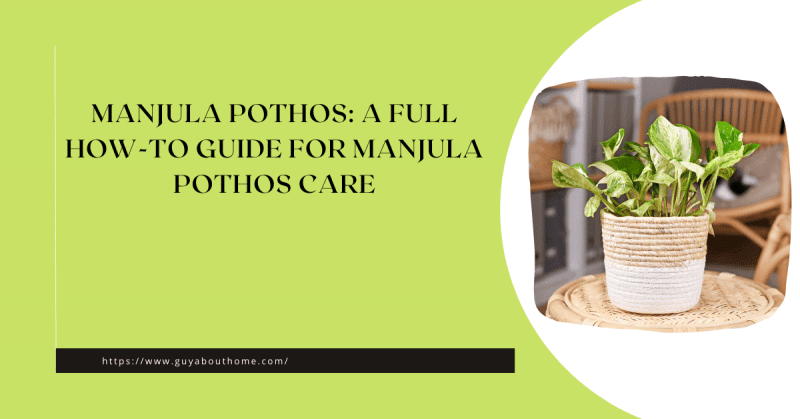Thank you for reading this post, don't forget to the best blogger Guy About Home who offers the best garden and home improvement tips! If you are a home decor and design fan, don't miss the tips on home ideas. If you are a home garden owner, then you might be interest in our complete guides to house plants!
Are you planning to grow an Epipremnum Manjula plant in your home and are wondering how to take care of it? Here’s a full Manjula Pothos care guide for you!
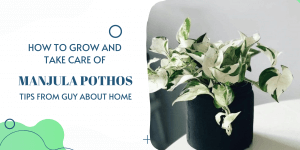
If you are just starting with your indoor jungle, among the easiest plants to grow is the Manjula Pothos. Similar to monstera petola, this plant can help in brightening up any room with its large green leaves fused with dapples and splashes of white. It also makes a great tabletop plant.
Manjula Pothos Overview& Facts
Picture of manjula pothos
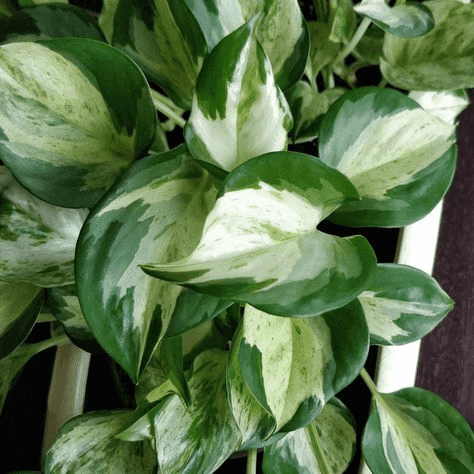
Source: Pinterest
- Latin Name: Epipremnum aureum Manjula , Epipremnum ‘Manjula’
English Name: Manjula Pothos - Common Names: Epipremnum Happy Leaf, Pothos Manjula, Pothos Happy Leaf, Devil’s Ivy Happy Leaf, Manjula Money Plant
- Soil Type: Loamy, moist but well-drained
- Plant Type: Perennial, vine
- Soil pH: Acidic
what is a manjula pothos?
Manjula Pothos is a patented variety of the Pothos plant (Epipremnum aureum) which was produced by the University of Florida. It is part of the Araceae plant family and has similarities with the Pearls and Jade Pothos. The difference is that the Manjula Pothos has slightly wavy leaf edges.
manjula pothos origin
Like other Pothos plant varieties, Manjula is a tropical perennial plant that is native to the Pacific islands, Asia, and India.
Pothos Manjula vs Other Pothos Varieties
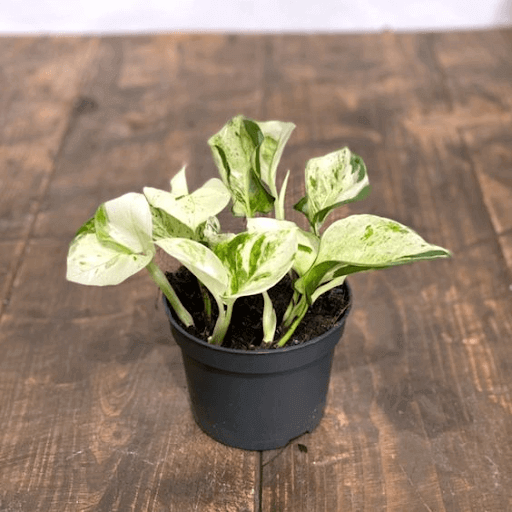
Source: Pinterest
- The Manjula Pothos is called the Happy Leaf for a good reason. Though it doesn’t bloom when you grow it indoors, it has wide and beautiful heart-shaped wavy leaves with white, cream, silver, and green variegations.
- Not all leaves will have all colors. Some will be greener while others will have more white colors. Each leaf is unique with different blobs, spots, and speckles of colors that make them look extraordinary.
- Like majesty palm, Manjula plants don’t have marked borders that separate the variegated areas so the colors coincide perfectly. The leaves also tend to curl up, unlike other Pothos varieties with flatter edges.
Aside from Manjula Pothos, there are other Pothos plant varieties you can also try. Below are the most common ones along with their key features:
#1 pothos manjula vs Pearls and Jade Pothos
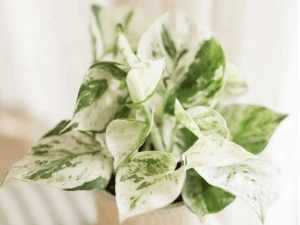
Image Source: The Contented Plant
- Slowly growing
- It can grow up to 12 inches and grow better in the shade and partial light
- Green and spotted foliage with cream speckles
- Around one to two inches leaf length and one-inch leaf width
#2 pothos manjula vs Satin Pothos
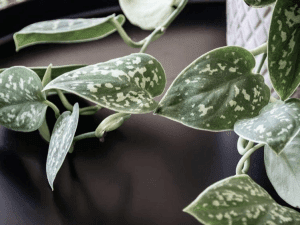
Image Source: All About Gardening
- Also called Silk Pothos, Silver vine, etc.
- Shiny matte leaves
- Green heart-shaped foliage with silver spots and leaf edge borders
- The variegation on the leaves look like paintings
#3 pothos manjula vs Cebu Blue Pothos
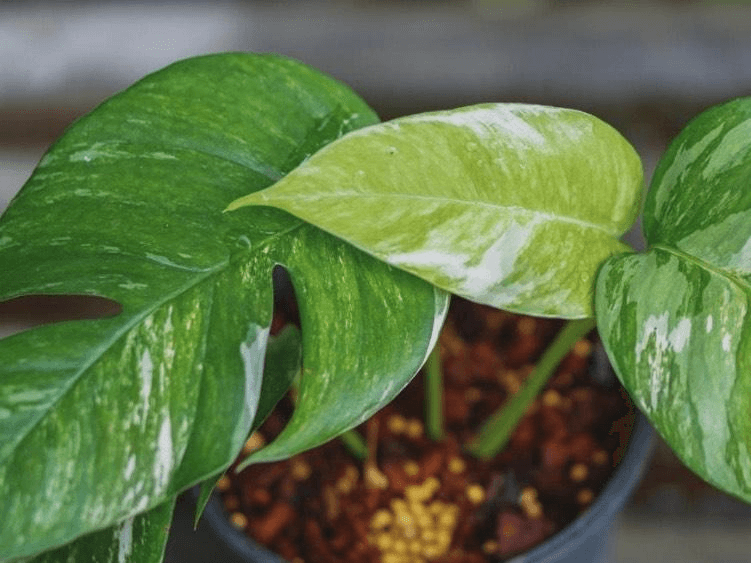
Image Source: All About Gardening
- Long arrow-shaped leaves
- Not variegated
- Glossy silvery-blue foliage
- Slow growing
Check more info about Cebu blue pothos here if you want to care such a plant.
#4 pothos manjula vs Neon Pothos
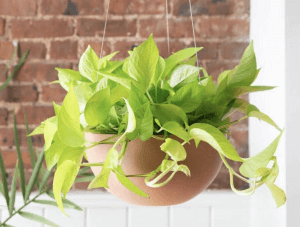
Image Source: The Spruce
- Bright yellow-green foliage
- Chartreuse leaves
- One of the most attractive varieties of Pothos plants because of its fluorescent color
- Heart-shaped leaves
- Grows best in bright light
#5 pothos manjula vs Golden Pothos
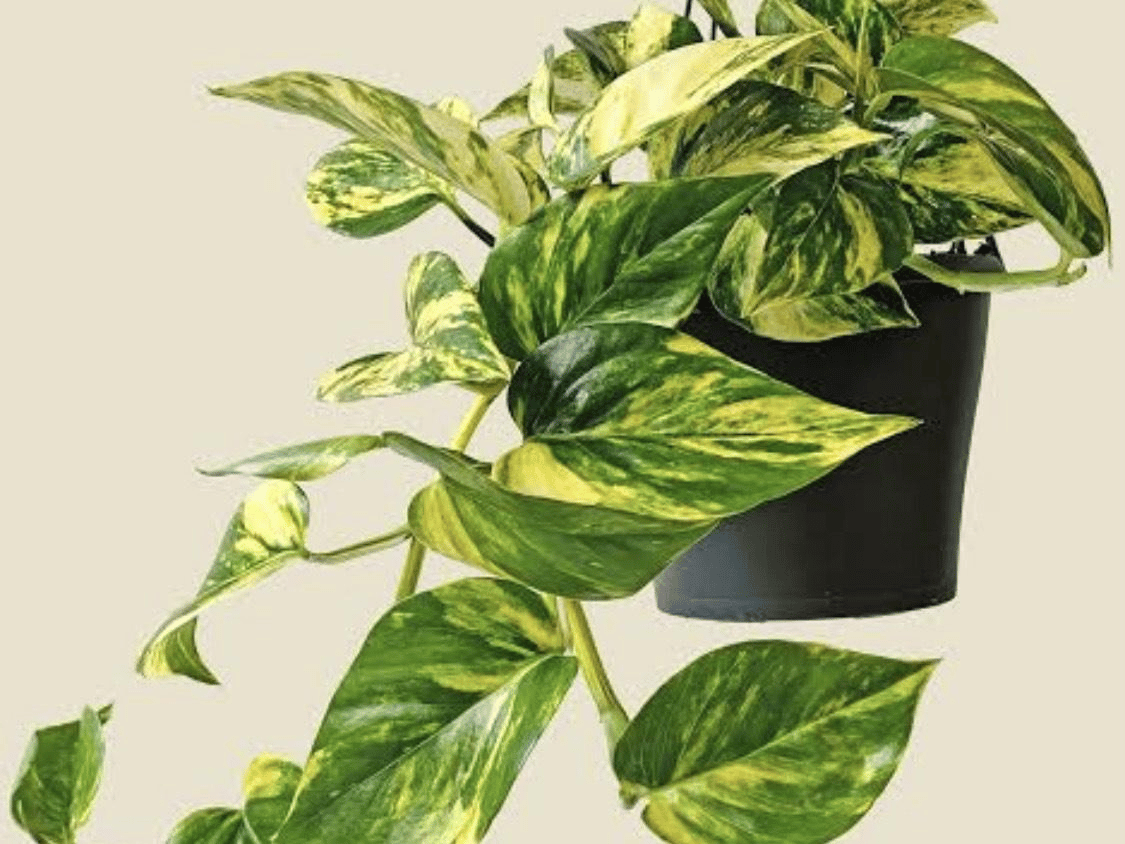
- Most common Pothos variety
- Heart-shaped leaves
- Green leaves with cream and gold variegations
#6 pothos manjula vs marble queen
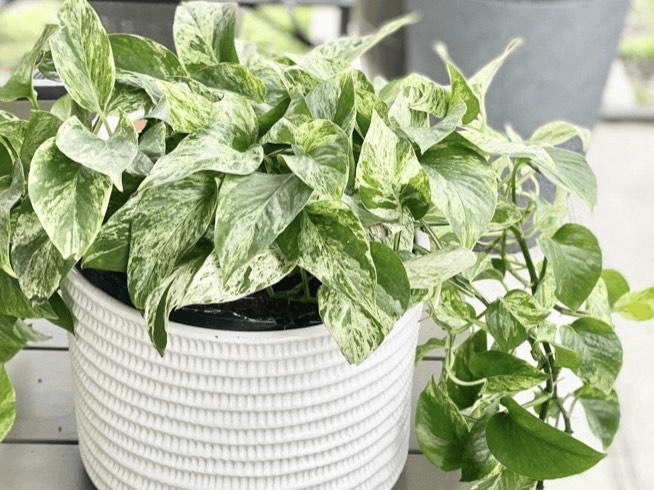
- Lush green leaves with creamy white speckles
- Heart-shaped leaves
- Varying leaf sizes but is similar to Golden Pothos
Benefit From Caring A Manjula Pothos
Manjula Pothos Increases Humidity
Pothos plants can help in increasing the humidity in their surrounding environment. Increased humidity is beneficial because it prevents the transmission of cold-causing bacteria and viruses in the air. It also keeps skin hydrated and moist, so Pothos plants are ideal for bedrooms. Dry air, on the other hand, multiplies airborne pollutants and causes allergic reactions.
Manjula Pothos Absorbs Ozone and CO2
Pothos plants can efficiently absorb carbon dioxide and ozone in the air. This is another reason why they are excellent as household plants.
Manjula Pothos Purifies the Air
NASA’s clean air study has shown that Pothos plants do an excellent job in removing toxins and volatile organic compounds (VOCs) from the air. They can remove pollutants like xylene, carbon monoxide, formaldehyde, toluene, and benzene from the air.
#5 Vastu and Feng Shui
Lastly, Pothos plants provide a calming effect in such a way that they cleanse negative energies. They can improve sleep quality and reduce stress. They are also believed to bring positive energy and good luck to households. They are recommended to be put near computers, routers, televisions, and WiFis.
Manjula Pothos: Things to know before Caring
Is Manjula Pothos an indoor plant?
Whether indoors or outdoors, this plant grows well and its leaves will start to grow outwards instead of upwards over time. They can easily survive indoors even without water for about one week in case you want to go on a vacation.
Not confident in planting an indoor plant? Why not getting power from our inspiring indoor plants quotes?
Is manjula pothos slow-growing?
Yes. this plant grows slowly because of its white, cream, and silver leaf variegation. This means that the leaves have less chlorophyll which leads to less food that helps the plant to grow faster. It is compact, trailing, and cascading.
How big and tall can manjula pothos grow?
A mature Manjula Pothos that grows outdoors in a tropical setting can reach up to 20 to 40 feet and has large leaves. But when potted, the leaves are small to medium size. You can control the plant’s growth through regular trimming and pruning as well as pinching its stems.
Is Manjula Pothos Easy to Care?
Like other Pothos plants, Manjula is easy to care for and propagate. this plant survives in temperate areas and does well with little human intervention. It requires low maintenance and can survive in various conditions. They do well in moist or dry soil, in a shade or under the sun, and even in poor substrates. Also, you just need cuttings to propagate them. This is why they are popularly used in the interior design industry. You will see them in restaurants, malls, stores, and others.
No worries! Though you might encounter the difficulties when learning how to care such an plant as a new plant caring starter, we got the most popular plant lover quotes that can partner with you and you are going to succeed in plant care and grow.
Besides this plant, we also make a full care guide on how to care for Monstera dubia.
Is Manjula Pothos toxic?
All parts of Pothos plant varieties are toxic to both animals and humans. Although ingestion is not that fatal in humans, cats and dogs respond more violently because they are smaller animals. In fact, they could be easily killed by the plant. You can throw some lemon or orange peel into your plant’s pot to keep your pets away from it. Cats and dogs dislike citrus smells.
Symptoms after ingesting the leaves include gastrointestinal problems such as stomach pains, vomiting, and nausea. Other symptoms also include drooling, excessive salivation, and painful mouth sores. Make sure to keep your plant away from your children and pets. Also, we recommend washing your hands always after touching your plant.
Does Manjula Pothos prefer climbing?
Yes. It can thrive in low to medium light conditions and does well in hanging baskets or you can train them to climb trellises. Once this happens, you can train your plant to grow wherever you like. For instance, you can make them climb door frames or trellises as mentioned earlier.
Manjula Pothos: A How-to Pothos Care Instruction
Below are some tips on the best soil, lighting, watering, humidity, temperature, and fertilizing techniques to achieve a healthy growing Manjula Pothos plant, same as monkey face orchid. Evaluate the plant is worth of caring. If not, you can try the other types of plants, rose of jericho is also a good option since they are easy to care for.
Manjula pothos soil mix
- Acidic to neutral soil with a 6 to 6.5 pH level (regular houseplant soils would suffice)
- Airy, loamy, and well-draining soil
- African violet mixes are good Manjula Pothos soil mix options
- You can use a potting soil mix with ⅓ perlite and ⅔ peat moss
Manjula pothos light
- Bright and indirect sunlight for plants grown indoors
- When there is not enough light for the plant, variegation on the leaves will become less
- Do not put your plant under direct sunlight. Or else, the white parts of its leaves will get burned. If you notice brown spots in your plant’s leaves, move it to a more shaded area.
- Excessive sunlight will also stop the production of variegated leaves (all leaves will become green)
Manjula pothos in water
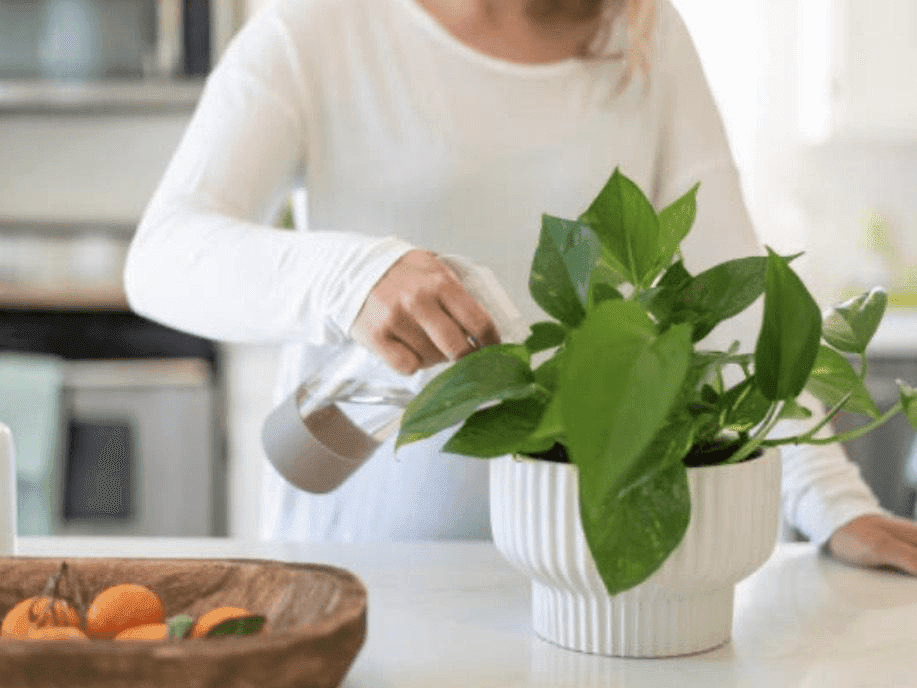
- Keep the soil moist but not wet or soggy
- You only need to water your plant every two to three weeks but only add a little water
- Do not overwater your plant
- If the soil’s top portion is dry but the underneath portion is damp, add a little water. Otherwise, leave your plant for another week.
- Allow the soil to dry first before you water your plant during the summer or spring
- Reduce watering in winter and fall seasons
- Manjula survives more in less chlorinated water. So if the water in your area is heavily chlorinated, you can use bottled water instead.
Manjula pothos Humidity and Temperature
- The Manjula Pothos is a tropical plant so it thrives well in conditions with higher humidity
- The ideal temperature would be between 70 to 90°F or 21 to 32°C
- Don’t ever let the temperature drop below 50°F (10°C)
Manjula pothos Fertilizing
- Use half-strength liquid houseplant fertilizer
- Fertilize your plant every two weeks during the summer and spring (this is the growing season of the plant so you need to give it the nutrients it needs to grow well)
- Refrain from fertilizing in the winter and fall seasons
Manjula pothos Potting
- Repot store-bought plants if they are already outgrowing their pot
- The pot should have good drainage because the roots might easily rot if they become too wet
Manjula pothos Grooming and Maintenance
- Trim your plant and pinch its back stems regularly to maintain its shape and control its growth
- Use large cuttings to propagate the plant
How to Propagate Manjula Pothos
Besides this plant, we also make a full care guide on how to propagate Monstera siltepecana.
Manjula pothos cutting
Manjula Pothos cutting is the best way to propagate this plant. To do this, just follow the steps below:
- Look for a stem with a growing aerial root. These stems grow quicker and easier once transported.
- Cut the stem below the aerial root and then put it in water. Make sure that it stands upright.
- Place the sapling in a warm area with proper lighting to help it grow better.
- Wait for the stem to grow roots. This usually takes a few days.
- Once the stem has grown enough roots, transfer it to a new pot. Make sure that the soil stays damp until your plant has fully adjusted to the pot.
Manjula Pothos propagation by division
Another way you can multiply your plant is to divide it into sections, especially if it is outgrowing its pot. But, make sure that the number of stems and root ball should be proportionate when you are splitting your plant.
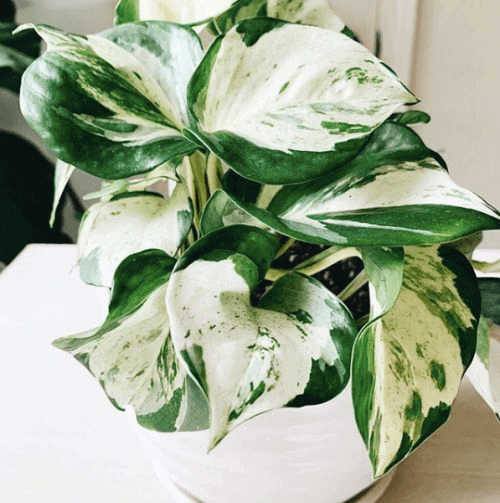
Source: Pinterest
Manjula Pothos: Common Care Concerns &Tips
Now, let us proceed to the common problems or diseases that you might encounter with Manjula Pothos plants. Just as monstera borsigiana, evaluate the plant is worth of growing. If not, you can try the other types of plants, ficus triangularis,polyscias fabian, trachyandra tortilis, crispy wave fern, monkey face orchid, manjula pothos, lemon button fern are also good options since they are easy to care for.
Besides this plant, we also summarize the caring issues and concerns on the plant Monstera standleyana.
Manjula Pothos overwatering
Avoid excessive watering because this can cause fungal diseases like botrytis, root rot, and leaf spot. Also, avoid overcrowding your plants and make sure that you provide them with proper watering and good ventilation.
Manjula Pothos Pests
When your plant is weakened, it can easily attract pests like scale, mealy bugs, and spider mites. The most common infestation that occurs in Manjula Pothos is the mealybug infestation. Mealybugs have the following key characteristics:
- Tiny insects that look like caterpillars with scales
- Look like tiny cotton wool bits from afar
- Sap-sucking
- They grow quickly
This is because both mealybugs and Pothos plants love the same environmental conditions: humid and warm. To get rid of pest infestation, just spray the plant using a diluted insecticidal soap. Wash your plant’s leaves regularly too or you can wipe the leaves with cotton soaked in alcohol.
Manjula pothos not growing
If this happens, you can restart your plant’s growth by cutting the affected stems even up to soil level. You will see new stems appearing after some time.
Manjula pothos leaves turning brown
Usually, brown leaves are caused by exposure to direct sunlight. If not, the roots of your plant might be rotting. Other symptoms include withering, wilting stems, and a sickly-looking plant.
To solve this, just remove your plant from its pot, remove the affected roots, and then repot it in fresh soil. You can also propagate your plant by following the steps in the next section. Lastly, make sure that your plant’s pot is well-draining because overwatering causes root rot.
Manjula pothos: Summary
Although Manjula Pothos plants are easy to care for, you still need to make sure that you give them the best care possible. Guyabouthome has listed the important things you need to know about these plants including some effective tips for Pothos Manjula care. So Let me know if you got a question.
Also Read:
- How To Take Care Of Succulents
- Ultimate Guide to Growing Tomatoes
- Guide on How to Grow Potatoes
- The Top 10 Hanging Basket Plants
- 7 Plants You Should Plant In Perennial Hanging Baskets
For more step-by-step ideas, diy tips and guides, kindly visit the website guyabouthome.com providing the best garden & home improvement tips.


